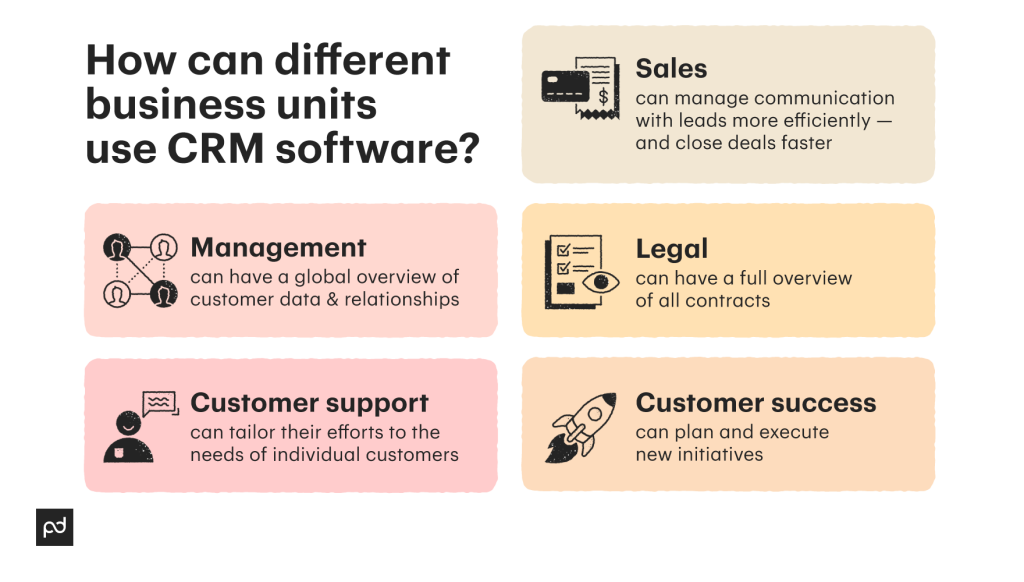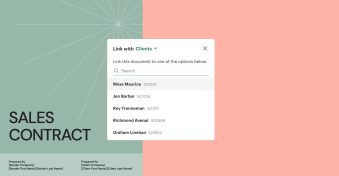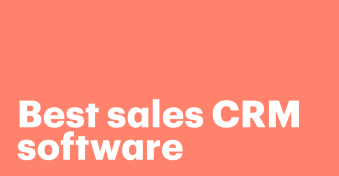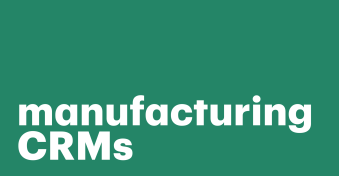Managing contact details, tracking deal sizes, and keeping up with prospects and customers can quickly become overwhelming for any sales team.
That’s why most businesses no longer rely on spreadsheets or manual data entry processes. Instead, they turn to customer relationship management (CRM) software. A CRM is a centralized platform that organizes customer data, streamlines contact management and communication, and integrates with other tools to speed up everything from follow-ups to sales proposals.
But what exactly is a CRM, and why is it so valuable for your business?
What is a CRM and do you need a CRM system?
Customer relationship management (CRM) software is a platform that aggregates all customer data in one place—giving teams a real-time, single source of truth to foster close client relationships and drive business outcomes.
What does a CRM do?
Typically, a CRM:

- Acts as a central hub accessible to all teams and departments, allowing for real-time updates.
- Allows everyone to work together seamlessly — helping your team build long-term relationships, identify strategic sales opportunities, and above all, provide an outstanding customer experience.
Reduces customer churn and maintains steady subscription renewal rates (for example, SaaS-based companies) by shifting the focus from transactions to relationships.
How does a CRM improve customer retention?
CRM software plays a critical role in improving customer retention by transforming raw data into personalized, actionable insights to strengthen customer interactions.
Here’s how CRMs help businesses retain customers more effectively:
Personalized customer engagement
Modern consumers expect brands to understand their needs. CRM systems store detailed profiles—purchase history, preferences, support issues—enabling tailored communications and offers.
For example, automated workflows can trigger a follow-up email or loyalty offer after a customer interaction, increasing the chances of repeat business.
Consistent omnichannel experience
With omnichannel buying behavior on the rise, customers interact via websites, social media, email, chat, and phone. A CRM ensures every team has access to the same real-time data.
This consistency prevents miscommunication, reduces friction, and builds long-term trust.
Proactive customer support
By tracking all support tickets and interaction history, CRMs allow your team to resolve issues faster—and even anticipate problems before they occur.
Proactive service reduces churn and shows customers that you’re invested in their success.
Timely follow-ups and reminders
CRMs automate critical follow-ups, such as subscription renewals, product education, or satisfaction surveys, keeping customers engaged throughout their lifecycle.
Data-driven retention strategies
Analytics and reporting tools within a CRM let you monitor churn rates, identify at-risk accounts, and segment your customers by loyalty or behavior.
This empowers businesses to intervene early and deploy targeted retention campaigns.
Do small businesses need a CRM?
CRM software isn’t just for large enterprises; companies of all sizes across industries use CRM software to track deals, details on potential customers, and manage customer data.
Even with a lean team, managing customer relationships manually becomes overwhelming fast.
CRM solutions help by:
- Centralizing customer data in one accessible place.
- Automating routine tasks like follow-ups, reminders, and lead assignments.
- Tracking sales pipelines to prevent lost opportunities.
- Improving team collaboration, even with just a few employees.
Providing valuable insights to understand customer behavior and buying patterns.
What are the three types of CRM?
CRM systems generally fall into three categories:
- Operational CRM: Automates customer-facing processes, including lead generation, sales marketing campaigns, and support service.
- Analytical CRM: Collects and analyzes customer data for sales teams to glean actionable insights to improve performance and sales forecasting.
- Collaborative CRM: This type of CRM enables information sharing across teams, like sales, marketing and support.
Most modern CRM systems integrate all three types into a single customer management solution.
How does CRM software benefit your customers and your business?
Let’s now look at all the main benefits of CRM software, to see how it can help you achieve more and drive the results you’re after.CRM software enables you to:
1. Redefine the way you manage your customer relationships
Relationship selling is much more efficient compared to other sales methodologies, and CRMs help specifically highlight that objective: build and enhance relationships.
In the traditional sales approach, a sales rep makes a sales pitch and then works through the prospect’s objections.
Using this method, the relationship usually ends right there, with or without a sale.
Relationship selling, on the other hand, means that you consistently put your customers’ needs first and strive to create meaningful relationships based on understanding and connection — and provide value beyond the sale.
Aside from the increase in customer satisfaction, relationship selling is tied to better customer loyalty and sales performance.
CRM software is the tool that enables you to build these relationships, and do that at scale, without being limited to the columns of an Excel sheet — or, even worse, to your memory.
With the right CRM product in your arsenal, you can consistently provide excellent service by checking all customer data before each interaction (or during interactions, when you’re dealing with an inbound request), and know exactly where your customer stands, what their needs are, and what past objections they had.
This way, you’re also able to foresee possible frustrations and manage them proactively, as well as identify disengaged customers and look for ways to bring them back.
2. Have a global overview by connecting data from all your systems
By integrating your CRM with other apps, you can centralize your data and make sure it flows easily between all the BI tools you’re using.
This enables you to have a comprehensive overview of each customer relationship and of your entire customer base — in fact, over 22,000 PandaDoc accounts currently benefit from CRM integrations to manage contracts, proposals, and instantly check the status of all docs waiting to be signed.
On an individual level, having the timeline of each relationship before your eyes, along with key interactions, helps you strengthen the connection with each customer and provide a tailored, personalized service.
On a global level, armed with the data on all your customer relationships, you’ll be able to identify:
- High-potential relationships that haven’t reached maturity yet, and then reach out to those customers to deepen the relationship and bring it to the next stage
- Issues that might turn relationships sour down the line, addressing them before they do — and before they lead to customer churn
- Nearly closed deals where you might need one extra call to get your lead to convert
- Opportunities to rekindle relationships with inactive customers, to check in with them and make sure they have all the information they need to make the most of their subscription
This 360-degree visibility becomes even more powerful when CRM is paired with CPQ (Configure, Price, Quote) software. CPQ tools pull customer data from the CRM to automate and streamline the quoting process, ensuring accurate, tailored quotes are generated in real time. This synergy reduces friction in the sales cycle and enables reps to close deals faster, with greater precision.
3. Shorten the sales cycle
One of the best ways to shorten the sales cycle is to frequently touch base with new leads, and not let them cool down and run to one of your competitors — while also maintaining a relationship with leads that are lukewarm but still show some potential to convert.
For this, you need a global overview of all your leads and sales activities to know the stage of the sales cycle where each one currently is.
Another benefit of CRM tools is that they enable you to regularly clean your lists of cold leads, redirecting any time and effort you’d spend with them to other leads who have a higher potential.
And one more way to speed things up: a CRM makes it easier for your leads to sign contracts, regardless of the device or channel they’re using.
4. Use a personalized approach at scale
Automation allows you to get tailored messaging out at scale.
Recurrent interactions are much easier to manage with a CRM tool, and you’ll be far better prepared to personalize your message if you have all customer data at your fingertips at all times.
Email is one of the best ways to personalize your messaging, but it can also be a productivity drain for salespeople — in fact, professionals check their email 15 times per day on average.
A CRM platform helps you optimize by:
- Storing all relevant information together
- Automating follow-ups
- Keeping track of all customer interactions
Automation is one of the best ways to personalize interactions while still staying efficient, and most CRM systems offer exactly that.
They help you automate repetitive tasks, look up data, and use it in the best way possible to provide customized service.
For CRM automation to be successful you need to make sure all tools from your tech stack are well-connected with each other, ensuring that your data flows smoothly.
5. Measure the ROI of sales, marketing, and customer support
Most CRM tools come with powerful reporting and analytics capabilities, which help you track each customer journey from A to Z, and see how the lead was sourced (marketing), what made them convert (sales), and how they interacted with customer support before and after converting (customer support).
This way, you can analyze the ROI of each team’s efforts and identify and further develop successful initiatives and approaches.
Additionally, you can make informed decisions about sales quotas and tailor your outreach tactics to your audience’s preferences — and gear it toward what works best for them.
How can different business units use CRM software to their advantage?
Each department or business unit will likely use CRM software differently, and with a different goal in mind.
This flexibility is one of the core benefits of CRM platforms.

Management can have a global overview of customer data and relationships
To identify the best strategic opportunities for growth, you need to be able to look at your customer data in its entirety and have access to actionable insights.
Most businesses understand this: 93% of companies plan to continue to increase investments in data analytics.
CRM platforms collect and aggregate data from different sources, giving you a complete overview of your customer base and your sales pipeline.
This makes them an excellent tool to gain an in-depth understanding of customer behavior, the success of current sales processes, identify weak points and opportunities for improvement in customer interactions, and so on.
The sales team can manage communication with leads more efficiently — and close deals faster
CRM platforms are an invaluable tool for sales development representatives (SDRs), as they enable them to:
- Maintain many relationships at once
- Streamline the decision-making process
- Automate follow-ups and regular check-ins
- Personalize their messages
- Adapt their approach to each customer’s preferences and needs
- See which strategies work best — and which ones don’t
- Close deals faster
For the last point, using a comprehensive contract management tool is crucial, as it enables the sales team to prepare and send contracts at a fraction of the time they’d otherwise need — and also makes it super easy for leads to sign.
PandaDoc integrates directly with leading CRMs like Salesforce, HubSpot, and Pipedrive, making it easy to create, send, and track documents without leaving your CRM. You can auto-fill proposals, quotes, and contracts with deal data, then track when prospects open, view, or complete the document—all from the same place you’re managing your pipeline.
Legal can have an open window into all contracts
CRM and legal are not often discussed together, but that’s a mistake: your CRM platform can be a valuable asset for your legal department as well, and serve as a point of reference for all contract information with your customers, allowing the legal team to access it easily whenever necessary.
Your legal department may simply pull all contracts your company has with clients and review them whenever they need to double-check something, review the contract of a long-term client, or compare contracts.
Additionally, using a CRM with PandaDoc makes it easy to prepare, create, and send new contracts — which sometimes requires your sales team and your legal department to work together.
Customer support can tailor its efforts to the needs of individual customers
CRM apps empower your customer support team, too, by giving it access to all the information they need to better understand and serve customers.
With the help of a CRM platform, customer support can easily check past interactions of the client, their purchase history, and also any notes other team members might have added to their profile.
All of this helps provide a personalized service that is tailored to the needs of each customer, taking into account their specific preferences.
This can also help you address any issues before they turn into problems, and make sure each customer knows how to make the most of each service or product they’ve purchased.
Customer success teams can plan and execute new initiatives
In addition to all of the above, a CRM system enables customer success teams to create and develop new campaigns and better measure outcomes.
Customer success teams work at the intersection of sales and customer support, helping customers make the most of each purchase and also moving them to the next step in your sales pipeline, either by upselling or cross-selling other products or services.
For this, they need a CRM to obtain detailed, up-to-date customer information, including past interactions, purchases, and preferences — this allows teams to scale their efforts, use new approaches, and design new customer success initiatives.
What is the best CRM tool to streamline customer relationships?
There are plenty of CRM tools on the market, tailored to different businesses’ priorities, processes, and needs.
When exploring different options, there are several factors to consider. We advise you to look into the following when evaluating each platform:
- Usability: Is the platform easy to use or does it have a steep learning curve?
- Level of automation: Can the platform help you automate and simplify your processes?
- Customization features: Can the CRM system adapt to the needs and functioning of your business?
- Integration capabilities: Can your CRM connect to the rest of your technology stack effortlessly?
- Reporting and analytics: Does it have powerful reporting and data analysis capabilities?
Best in class: Salesforce sales cloud
Considering those factors, Salesforce Sales Cloud is one of the best CRM systems on the market.
It’s trusted by more than 150,000 organizations worldwide and was named a leader in Gartner’s CRM Customer Engagement Center (CEC) Magic Quadrant for over a dozen years.
Thanks to its customization capabilities and third-party app integrations (available on its AppExchange), Salesforce Sales Cloud is extremely flexible and versatile, allowing organizations to create a truly tailor-made solution for their needs.
And when you integrate Salesforce with PandaDoc, this is where the magic happens. For teams that use both tools together:
- The number of completed documents increases by 87%
- The time teams need to create documents decreases by 50%
- Deals’ close rate increases by 36%
This helps sales teams reach their optimal productivity level and shorten the sales cycle significantly, as they become more efficient in creating and managing documents — and, most importantly, in getting them sent and signed.
Teams are able to populate contract templates automatically by pulling data from Salesforce, which helps eliminate human error and check the status of each document in real time, creating a single information hub for everything sales-related.
Alternatives: HubSpot, Pipedrive, and more
There are a number of other popular alternatives to Salesforce, depending on your team’s needs.
HubSpot
HubSpot helps you bring your sales, customer support, and marketing teams closer and streamline their collaboration. Integration for HubSpot enables you to autofill, customize and send documents from the platform, and makes it easier to close deals.
Pipedrive
Pipedrive is built to help sales teams stay focused and organized, and the PandaDoc integration fits right into that workflow. You can generate, customize, and send proposals or quotes directly from a deal in Pipedrive—no tab-switching required. It also tracks document activity in real time, so you know exactly when a prospect opens or completes a doc.
PandaDoc with your CRM system — a winning combination
PandaDoc has everything your sales team needs to score more wins, including a rich set of CRM integrations that allow you to manage your entire sales cycle with a signal tool.
Integrating your CRM helps sales teams to quickly create fully personalized documents using a vast template library, share and track changes in documents in real time without leaving your CRM and provide a better experience for leads through automation.
Ready to give it a try? Start a free trial and see how much more powerful your CRM can become.
Disclaimer
PandaDoc is not a law firm, or a substitute for an attorney or law firm. This page is not intended to and does not provide legal advice. Should you have legal questions on the validity of e-signatures or digital signatures and the enforceability thereof, please consult with an attorney or law firm. Use of PandaDocs services are governed by our Terms of Use and Privacy Policy.
Originally published Mar 19, 2019, updated August 15, 2025


